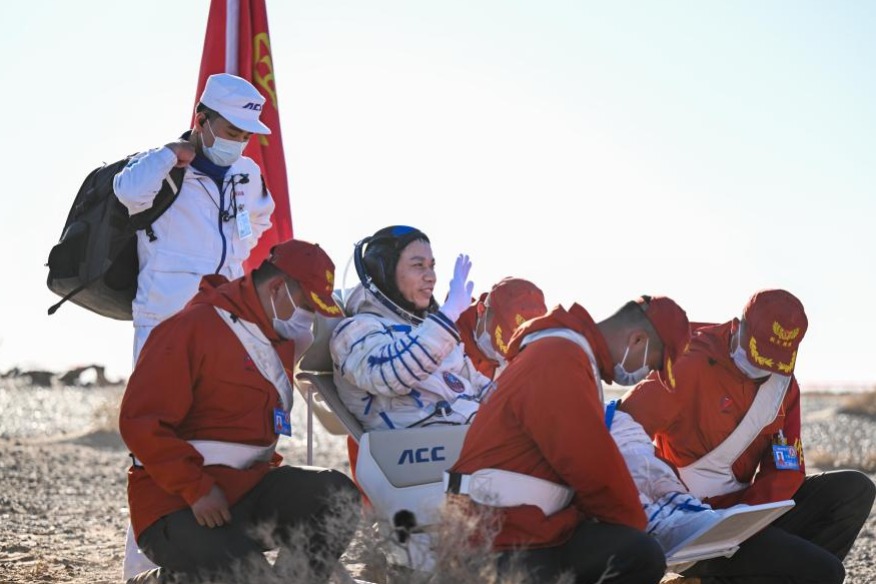Improvement of tracks, building new routes urged
By ARUNAVA DAS in Kolkata, India | China Daily Global | Updated: 2023-07-07 09:12
"Normal" services have resumed and life has returned to normal, but India is still reeling from the impact of one of the worst railway tragedies in its history.
At a time when the federal government led by Prime Minister Narendra Modi is going all out to upgrade the antiquated railway infrastructure, the crash in its eastern state of Odisha on June 2 has raised many questions.
The crash caused by "a change in the electronic interlocking system" guiding train movement happened on a day when Modi was to flag off a much-vaunted semi-high-speed train called Vande Bharat between Mumbai and Goa.
Instead, Modi had to reroute his journey and head to Bahanaga Bazar station in Odisha's Balasore district, the scene of the train crash.
The aftermath of the shock is thinning away and things are getting normal, but the safety standards of the state-run Indian Railways, which ferries 22 million people each day, is under the scanner yet again.
The June 2 tragedy has dealt a blow to the much-publicized modernization drive by the Modi government, which in recent years has built high-altitude bridges, unveiled state-of-the-art stations and even announced India's first bullet train, experts have said.
"India has achieved some success in making train journeys safer over the years, but a lot more needs to be done," Swapnil Garg, a former officer of the Indian Railway Service of Mechanical Engineers, was quoted by The Associated Press as saying last month. "The entire system needs a realignment and distributed development. We can't just focus on modern trains and have tracks that aren't safe."
The Odisha train crash should serve as a wake-up call, Garg said, adding that authorities should take a fresh and hard look at the lax safety culture.
However, Garg said he does not expect things to change overnight. The Indian railway system is huge and it will take time to make it safer, but there needs to be a will, he said.
Alok Kumar Verma, who has retired from the Indian Railways Service of Engineers, told The Christian Science Monitor, an international news organization, that India's railway network is being neglected, and consequences have been disastrous. He lamented that the country's railway is being ignored while airports and highways are being given a huge push.
The Indian rail system, which is the only affordable option for millions of Indians, especially the poor, "ranks low" globally when it comes to safety, Verma said, adding it is comparable to less developed countries, such as the Democratic Republic of Congo or Nigeria.
The main problem is congestion, he said. "Ideally, tracks should be running at 70 percent capacity to factor in maintenance, but on some of the country's busiest routes, they're operating well beyond capacity. Our routes are highly choked. ... This is a very alarming and worrying situation."
Overcrowding is another area of concern, said Samir Zaveri, a rail safety activist in Mumbai. Most coaches are often overcrowded, and when there is an accident, they mean more casualties, he said.
India's deadliest rail disaster happened in 1981, when a train fell into a river in the eastern state of Bihar, killing an estimated 750 passengers.
Zaveri, who lost both his legs in a rail accident more than 30 years ago, was quoted by The Christian Science Monitor as saying that these accidents, regardless of size, were the result of slipshod attitudes toward safety.
India is investing huge funds into revamping its railway network and safety upgrade. Its capital expenditure in it in the last financial year was about $23 billion.
Notable steps
Meanwhile, the government has dismantled all unmanned level crossings for passenger trains on broad gauge routes. Other notable steps include: Level crossings with heavy rail/road traffic are either manned or interlocked with signals for enhancing safety, and awareness campaigns have been launched to create greater degree of safety consciousness.
In December, Indian Railways developed an automatic, anti-collision device called Kavach to prevent accidents resulting from human errors. Kavach can control the speed of trains by automatically applying brakes on approach of turnouts, and through auto whistling at level crossing gates. A turnout is a movable piece of track that allows a train to change direction without stopping.
India has introduced new semihigh-speed trains with a design speed of 180 kilometers per hour. But track conditions are not conducive enough — a reason why such high-speed trains cannot run at their optimum speed, Zaveri said. It is like driving a luxury car on a bad road, Zaveri said. "What is the use?"
The writer is a freelance journalist for China Daily.
























